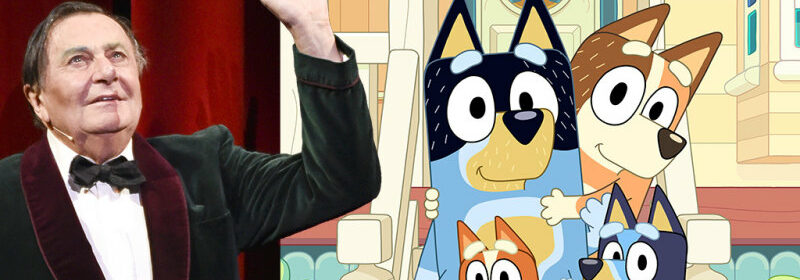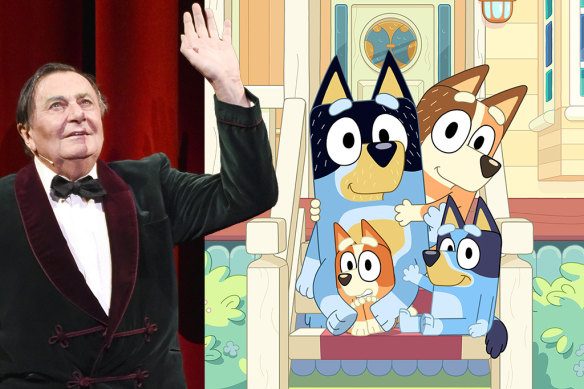Daks, dunnies and dobbers: What Bluey owes to Barry

Save articles for later
Add articles to your saved list and come back to them any time.
“A bush wee is when you’re in the bush without a toilet,” explains Leah Goulis on the video. “You basically drop your daks – your pants – and go to a tree and wee, and hopefully no one will see you.” Compare this to a tactical wee, Leah adds, where parents urge their kids to visit the bathroom before going to the movies, say.
Both urination variations are part of a longer video, embedded in a fan site for Bluey, the cartoon heeler who’s winning mates in America. Thanks to the show’s success, US parents are wondering about “dunny” and “whack-a-doo”, while their kids are using the imports anyway, along with “grub” and “dodgy”.
Barry and Bluey, iconic exporters of Aussie slang.Credit: Kirsten Burghard
Even “bluey” – the heeler breed – needs a footnote on the site, in tandem with Bluey’s cousin Rusty, who’s a “kelpie”, another head-scratcher for offshore fans. Loose translations, like stool pigeon for “dobber” or cream puff for “squib”, only highlight the raffishness you lose in clarifying Australian slang. Sure, a bin chicken is an ibis, but which label is more joyous?
Watching the explainer video, I find myself thinking of Bluey’s other cousins. Not the kelpie or Trixie Heeler, but the late dame called Edna, the cultural attaché called Sir Les or even the original larrikin in Bazza McKenzie. Before Joe Brumm’s Ludo Studio magicked a dog family to life, there was Barry Humphries, the ocker oracle of earlier decades.
Like a ghost of Chrissie past, Humphries haunts the Bluey scripts, his flair for the vernacular now furthered by the Heeler household, confounding a new lot of non-Australians. Since that’s the thing with slang; a playful means of affirming your belonging, slang is fashioned by insiders to keep outsiders guessing.
Until an ambassador comes along, a pollinator, like Bluey or an alpha bogan in Bazza McKenzie, Barry Humphries’ first caricature to invade the English psyche and its glossary. From 1960, running in Private Eye as a comic strip, The Wonderful World of Barry McKenzie, allowed Humphries to propagate “cobber” (versus dobber), “whacko-the-diddle-oh” (later reshaped by Bluey’s writers) and even the “daks” that Leah Goulis, the arch-fan, mentions in her video.
Not that Humphries coined daks, since that’s the other slang element. As street-speak, the dialect owns as many folk sources as dodgy claimants. Daks is thought to be a blend of designers’ initials, trademarked by Piccadilly couturier Alexander Simpson in 1934. Only for some fictional Aussie galoot to align the garment with such bonzer activities as “dipping the wick”, “draining the dragon”, or “pointing Percival at the porcelain” – alias, Bluey’s dunny.
Howard Manns, a senior lecturer in linguistics at Monash, cowrote a tribute to Barry Humphries last week in The Conversation, recognising the satirist’s gift for Australian slang, as much as the verbal legacy he leaves. Just as Henry Lawson and Banjo Paterson evoked boiling billies and waltzing Matildas in our imagination, the likes of Edna and Les lit the fire under a “kookaburra’s Khyber” and the “liquid laugh”.
I know Humphries had his detractors. For the record, back in 2018, I pulled a crossword with a Dame Edna theme, owing to the comedian’s insensitive slam of the transgender community around the same time. Despite the polarising, the man had a unique ear for how we speak, and a knack for furthering the bawdy carnival that is Aussie English, just as a pint-sized cattle dog is making Yanks marvel at jocks and sunnies.
Whichever persona Humphries took, from housewife to hooligan, I endorse The Conversation’s opener: “If slang is the people’s poetry, then Australia lost a poet last week.”
To read more from Spectrum, visit our page here.
Most Viewed in Culture
From our partners
Source: Read Full Article
